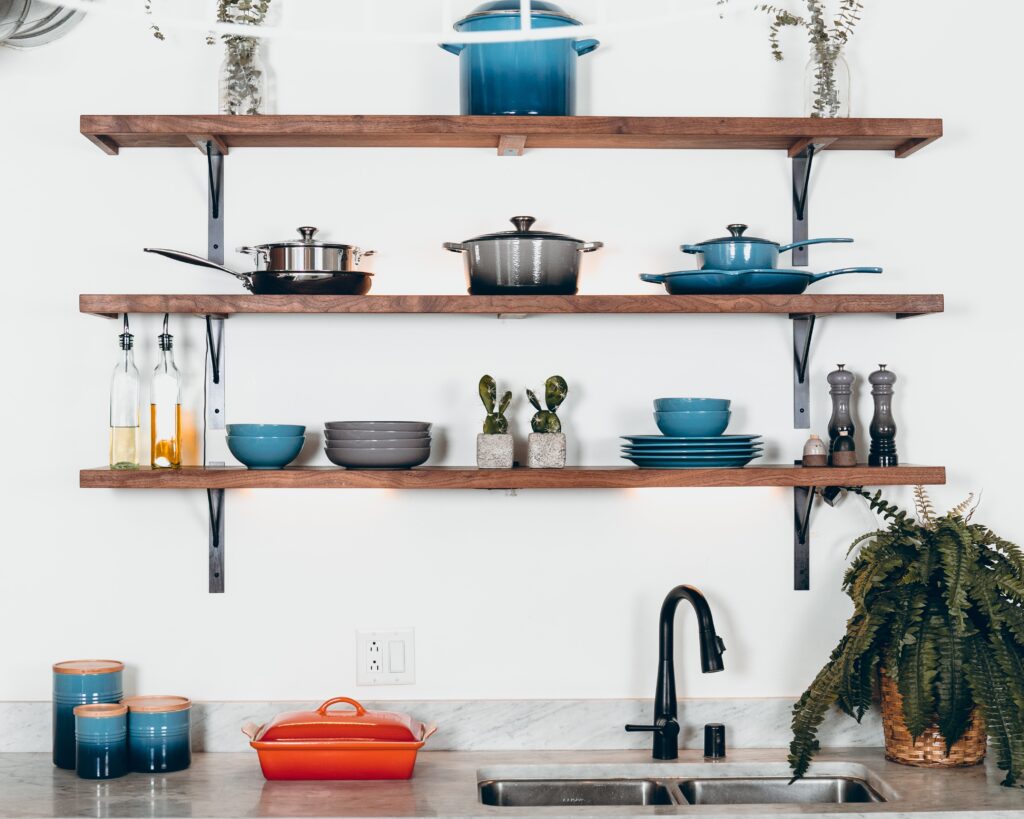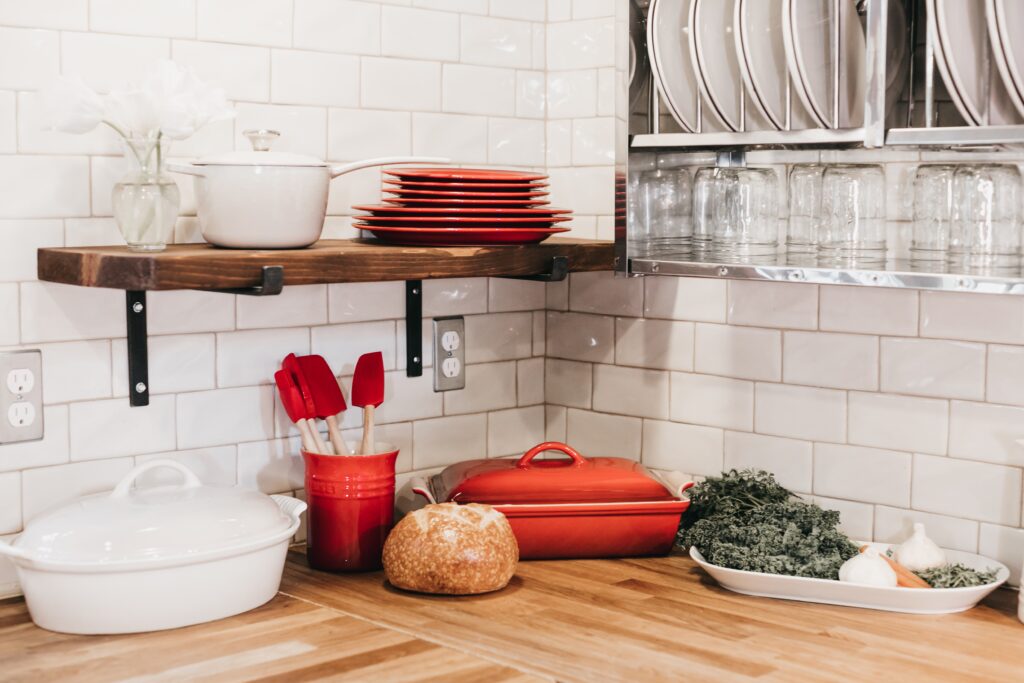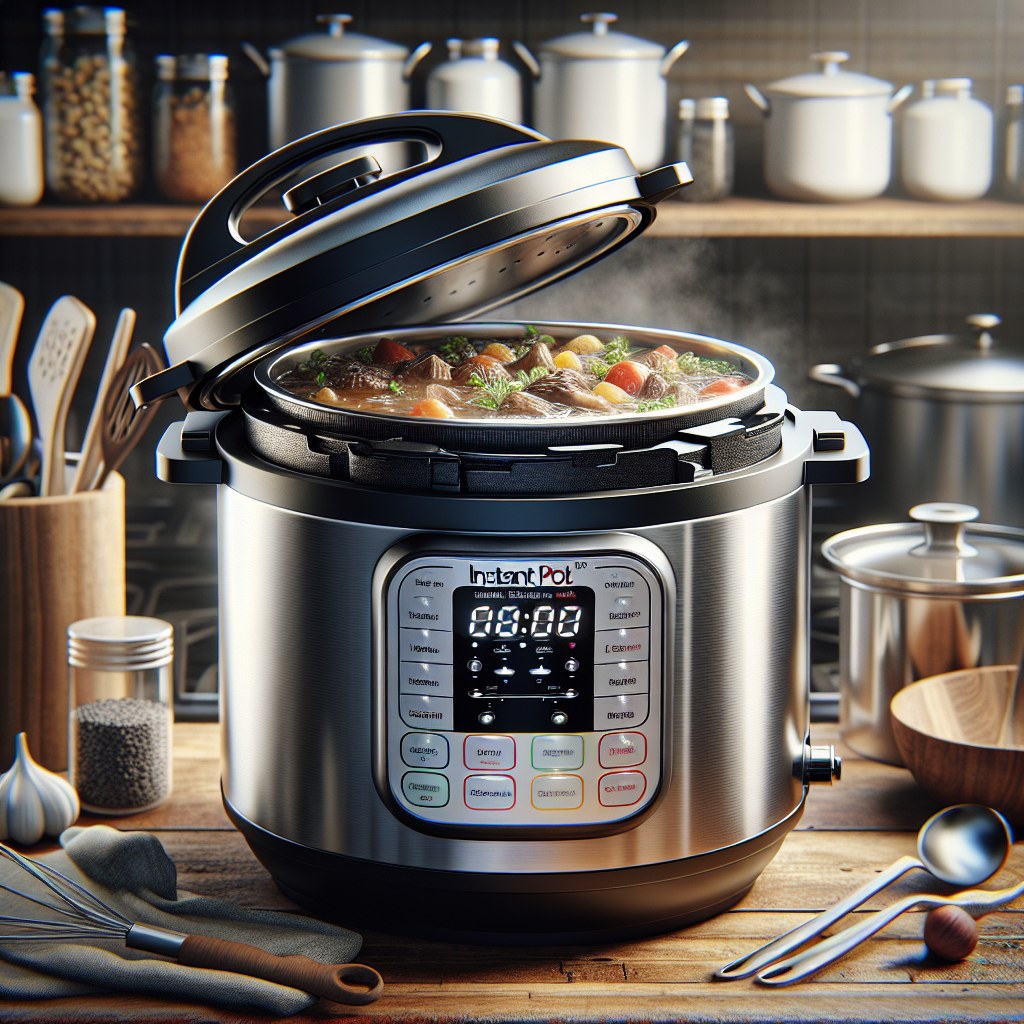The world of cooking just got a whole lot easier with the Instant Pot. Whether you’re a seasoned chef or a novice in the kitchen, this innovative appliance is here to revolutionize your cooking experience. In this article, we will guide you through the simple steps of utilizing the Instant Pot to whip up delicious meals in no time. Get ready to unlock a world of culinary possibilities with this incredible tool.

Getting Started
Unboxing the Instant Pot
Congratulations on your new Instant Pot! The first step in your culinary journey begins with unboxing this versatile and efficient kitchen appliance. Take your time to carefully unbox the Instant Pot, making sure to remove any packaging materials and accessories. Your Instant Pot might come with a user manual, a quick start guide, and additional accessories like a steam rack and measuring cup. Keep these materials handy as they will provide valuable information on using your Instant Pot to its fullest potential.
Understanding the components
To ensure a smooth and successful cooking experience, it’s essential to familiarize yourself with the different components of the Instant Pot. The main parts include the stainless steel inner pot, the lid, the control panel, and various buttons for different cooking functions. You’ll also find a steam release valve, a float valve, and a sealing ring. Understanding the purpose and usage of each component will help you navigate your way through the various cooking methods offered by the Instant Pot.
Cleaning the Instant Pot
Before diving into your culinary adventures, it’s important to give your Instant Pot a thorough cleaning. Start by removing the stainless steel inner pot, the sealing ring, and the steam rack (if included). Wash these components with warm soapy water, rinsing them thoroughly afterward. The lid and the control panel can be wiped clean with a damp cloth. Make sure to dry all the components completely before reassembling them. Regular cleaning and maintenance of your Instant Pot will contribute to its longevity and optimal performance.
Basic Functions
Pressure Cooking
One of the most popular functions of the Instant Pot is pressure cooking. With its ability to cook meals quickly and retain the flavors and nutrients of the ingredients, pressure cooking is perfect for time-pressed individuals. To use the pressure cooking function, start by preparing your ingredients. Whether it’s chopped vegetables, meat, or grains, ensure everything is properly prepared and ready to go. Next, add a sufficient amount of liquid, such as water or broth, to the inner pot. Secure the lid by aligning it properly and turning it clockwise until it locks in place. Select the pressure cooking function on the control panel and set the desired cooking time. Finally, once the cooking time is complete, release the pressure using either the quick release or natural release method.
Slow Cooking
For those days when you prefer a more leisurely approach to cooking, the slow cooking function of the Instant Pot is a game-changer. It allows you to simmer and slow cook your favorite dishes to perfection without tying up your stovetop or oven. Begin by choosing the appropriate temperature setting for your recipe—low for gentle simmering or high for faster cooking. Add your ingredients to the inner pot, ensuring not to overfill it. Secure the lid and set the cooking time according to your recipe. Throughout the cooking process, feel free to check on your food and give it a stir for even cooking. Once your dish is cooked to perfection, use the Keep Warm function to maintain its temperature until ready to serve.
Sautéing and Browning
The Instant Pot is not only a pressure cooker and slow cooker; it also has a sautéing and browning function, perfect for adding depth and flavor to your dishes. To start, select either the Sauté or Browning function on the control panel. Allow the pot to preheat before adding a small amount of oil or butter. Once heated, you can begin sautéing your vegetables or browning your meat directly in the inner pot. Stir occasionally to ensure even cooking. Once you’ve achieved your desired browning or sautéing, simply turn off the Sauté or Browning function.
Steaming
Steaming is a healthy cooking method that preserves the nutrients and flavors of your ingredients. The Instant Pot makes steaming a breeze with its included steam rack. Begin by adding an appropriate amount of water to the inner pot, as indicated by your recipe. Place the steam rack inside the pot, making sure it is elevated above the water level. Arrange your food on the steam rack, ensuring adequate spacing for steam circulation. Close the lid, making sure it is securely locked, and set the cooking time. Once the steaming process is complete, you can choose to quick release the steam or allow it to naturally release.
Rice Cooking
Cooking perfect rice is made easy with the Instant Pot’s rice cooking function. Start by measuring the desired amount of rice and water according to the recommended rice-to-water ratio. Rinse the rice thoroughly to remove excess starch. Add the measured rice and water to the inner pot, ensuring the ratio is correct. Close the lid and select the Rice cooking function on the control panel. Set the cooking time, depending on the type of rice you are using. Once the rice is cooked, allow for natural pressure release before opening the lid. Fluff the rice with a fork, and it’s ready to be enjoyed with your favorite dishes.
Yogurt Making
For those who enjoy homemade yogurt, the Instant Pot offers a yogurt-making function that takes the hassle out of the process. To make yogurt, start by preparing the milk. Heat the milk in the Instant Pot until it reaches the desired temperature. Once heated, allow the milk to cool to the recommended temperature range. Add the yogurt culture to the cooled milk and stir gently. Place the lid on the Instant Pot, select the Fermentation function, and set the desired fermenting time. After the fermentation process is complete, refrigerate the yogurt until it reaches your desired consistency.
Using the Control Panel
Understanding the buttons
The control panel of the Instant Pot features various buttons that correspond to different cooking functions and settings. Understanding these buttons is crucial for navigating the Instant Pot and achieving the desired cooking results. The buttons may include options for pressure cooking, slow cooking, sautéing, rice cooking, yogurt making, and more. Take the time to familiarize yourself with each button’s function and how it relates to the cooking methods you intend to use.
Setting the cooking time
Setting the cooking time on the Instant Pot is a straightforward process. Once you have selected the desired cooking function, you can adjust the cooking time using the “+” and “-” buttons on the control panel. The cooking time will depend on the recipe and the type of food you are preparing. It is crucial to follow the recommended cooking times provided in your recipes to ensure proper cooking. The Instant Pot will automatically start the cooking process once you have set the cooking time.
Adjusting the pressure level
The Instant Pot allows you to adjust the pressure level depending on your cooking needs. This feature is particularly useful for recipes that require high or low pressure cooking. Some recipes may specify the pressure level, while others may allow you to choose between high and low pressure based on your preference. Adjusting the pressure level is as simple as pressing the corresponding button on the control panel. The Instant Pot will then cook your food at the desired pressure level.
Using the delay start function
The delay start function of the Instant Pot is perfect for busy individuals who want to have a meal ready at a specific time. With this function, you can program your Instant Pot to start cooking your meal at a later time, allowing you to prepare in advance. To use the delay start function, select the desired cooking function and adjust the cooking time accordingly. Then press the delay start button and set the desired delay time. The Instant Pot will automatically start the countdown timer and begin cooking at the programmed time.
Canceling a cooking program
If you need to cancel a cooking program on the Instant Pot, there is a simple way to do so. Just press the Cancel button on the control panel, and the Instant Pot will stop the cooking process and return to the standby mode. This feature comes in handy if you need to make any adjustments to your recipe or stop the cooking for any reason. By canceling the cooking program, you have full control over the cooking process and can make any necessary changes.
Pressure Cooking
Preparing ingredients for pressure cooking
Before embarking on pressure cooking with your Instant Pot, it is essential to properly prepare your ingredients. Whether it’s meat, poultry, vegetables, or grains, ensure that they are washed, trimmed, and cut into appropriate sizes. Properly preparing your ingredients will promote even cooking and enhance the flavors of your dish. Additionally, make sure to remove any excess fat or skin from meat to avoid unwanted residue in the pot.
Adding liquid for pressure cooking
Adding the right amount of liquid is crucial for successful pressure cooking in the Instant Pot. The liquid is required to generate steam, which creates the pressure necessary for cooking. While the amount of liquid may vary depending on the recipe, a general guideline is to add at least one cup of liquid, such as water, broth, or sauce. This is usually sufficient for most recipes. However, certain dishes may require more liquid, so it’s essential to follow your recipe’s instructions.
Securing the lid
Properly securing the lid is a vital step in pressure cooking. Ensure the sealing ring is properly in place, free from any debris, and not damaged. Align the lid with the pot and turn it clockwise until it locks into place. The float valve should be in the sealed position, indicating a tight seal. This is crucial for building and maintaining pressure during the cooking process. Always double-check the lid to ensure it is locked correctly before beginning pressure cooking.
Selecting the pressure cooking function
Once the lid is securely in place, it’s time to select the pressure cooking function on the control panel. Depending on the model of your Instant Pot, the button may be labeled “Pressure Cook” or have a specific icon indicating pressure cooking. Press the button to activate the pressure cooking function. The Instant Pot will start building up pressure and begin the cooking process.
Setting the cooking time
After selecting the pressure cooking function, you can adjust the cooking time using the “+” and “-” buttons on the control panel. The recommended cooking time for your recipe should be specified in the directions. Set the cooking time accordingly to ensure your ingredients are cooked to perfection. Once the cooking time is set, the Instant Pot will begin the countdown and cook your ingredients under pressure.
Releasing pressure
After the cooking time is complete, it’s time to release the pressure from the Instant Pot. There are two methods for releasing the pressure: quick release and natural release. Quick release involves carefully turning the steam release valve from the sealed position to the venting position. Use caution while doing this, as hot steam will be released. Natural release, on the other hand, allows the pressure to dissipate gradually. Simply leave the Instant Pot untouched for a certain period, and the pressure will naturally release. The method of pressure release will depend on the recipe and the needs of your dish.

Slow Cooking
Choosing the right temperature
When using the Instant Pot’s slow cooking function, it’s important to choose the right temperature setting for your recipe. The slow cooker feature offers two temperature options: Low and High. Low is ideal for long, slow cooking, while High is suitable for faster cooking. Consider the nature of your recipe and the desired outcome to determine which temperature setting is most appropriate.
Setting the cooking time
Similar to pressure cooking, the Instant Pot allows you to set the cooking time for slow cooking. This will depend on the specific recipe, as certain dishes require longer cooking times than others. Select the desired cooking time using the “+” and “-” buttons on the control panel, considering the recommended time specified in your recipe. The Instant Pot will automatically begin the slow cooking process once the cooking time is set.
Adding ingredients to the pot
When slow cooking with the Instant Pot, add your ingredients to the inner pot. Depending on your recipe, you may need to layer or mix the ingredients accordingly. Do not overfill the pot, as this can affect the cooking process and result in unevenly cooked food. Remember to leave some space for the ingredients to expand as they cook.
Securing the lid
After adding the ingredients to the pot, secure the lid by properly aligning it and turning it clockwise until it locks into place. Ensure the float valve is in the sealed position, indicating that the lid is tightly secured. This will allow the slow cooking function to work effectively and maintain a consistent temperature throughout the cooking process.
Checking the food during cooking
Throughout the slow cooking process, you may want to check on the progress of your dish or stir the ingredients for even cooking. To do so, carefully open the lid and quickly check or stir the food. Remember to close the lid promptly to maintain the desired temperature and cooking environment. Each time you open the lid, it may increase the cooking time slightly due to heat loss, so aim to minimize the frequency of lid openings.
Using the Keep Warm function
Once your slow-cooked dish is ready, but you’re not quite ready to serve, the Instant Pot’s Keep Warm function comes in handy. This feature automatically kicks in when the cooking time is complete. It will keep your food at a safe temperature until you are ready to enjoy it. The Keep Warm function is especially useful when you want to keep your dishes warm for extended periods without overcooking them.
Sautéing and Browning
Selecting the Sauté or Browning function
To sauté vegetables or brown meat in the Instant Pot, you need to select the appropriate function on the control panel. The Instant Pot offers both Sauté and Browning functions, which can be used interchangeably depending on your recipe’s requirements. Press the corresponding button on the control panel to activate the desired function.
Preheating the pot
Before adding your ingredients, give the Instant Pot a few moments to preheat. This allows the pot to reach the desired temperature, ensuring efficient sautéing or browning. The Instant Pot will display the word “Hot” on the control panel when it is ready to be used.
Adding oil or butter
Once the Instant Pot is preheated, add a small amount of oil or butter to the pot. This will provide the necessary lubrication for sautéing your vegetables or browning your meat. The amount of oil or butter may vary depending on your recipe, so follow the instructions accordingly.
Sautéing vegetables or browning meat
With the oil or butter in the pot, start sautéing your vegetables or browning your meat. Add your prepped ingredients to the pot and stir them regularly to ensure even cooking and browning. The Instant Pot’s even heat distribution will help achieve the desired results. Remember to follow your recipe’s instructions for specific sautéing or browning times.
Turning off the Sauté or Browning function
Once your vegetables are sautéed or your meat is browned to perfection, it’s important to turn off the Sauté or Browning function. This can be done by pressing the corresponding button on the control panel. This step ensures that your ingredients do not overcook or burn while you proceed to the next stages of your recipe.

Steaming
Using the included steam rack
The Instant Pot usually comes with a steam rack, which is a valuable accessory for steaming. Place the steam rack inside the inner pot, ensuring it is elevated above the water level. This allows the steam to circulate and cook the food evenly.
Adding water to the pot
To generate steam for the steaming process, you need to add water to the instant pot. The amount of water will vary depending on your recipe, so follow the instructions provided. Typically, one to two cups of water is sufficient for most steaming recipes.
Placing food on the steam rack
Once the water is added, it’s time to place your food on the steam rack. Arrange the food in a single layer, ensuring there is space between each piece for the steam to circulate effectively. This allows for even and thorough cooking.
Securing the lid
With the food arranged on the steam rack, it’s time to secure the lid by aligning it properly and turning it clockwise until it locks into place. Ensure that the float valve is in the sealed position to maintain the necessary pressure and steam within the Instant Pot.
Setting the cooking time
After securing the lid, select the desired cooking time using the “+” and “-” buttons on the control panel. This will depend on the steaming requirements of your recipe. Once the cooking time is set, the Instant Pot will automatically begin the steaming process.
Quick releasing or natural releasing the steam
Once the steaming process is complete, you have two options for releasing the steam—quick release or natural release. Quick release involves turning the steam release valve from the sealed position to the venting position, allowing the steam to escape. Natural release, on the other hand, involves leaving the Instant Pot untouched for a specified period to allow the steam to dissipate gradually. The choice between quick release and natural release will depend on your recipe’s recommendations and your desired cooking results.
Rice Cooking
Measuring rice and water ratio
Before starting the rice cooking function, it’s important to measure the rice and water accurately for optimal results. The ratio of rice to water may vary depending on the type of rice you are using. A general guideline is to use one cup of rice to one and a half cups of water. However, it’s always best to refer to your recipe or the rice package for specific instructions.
Washing the rice
To ensure fluffy and separated rice grains, it’s recommended to rinse the rice before cooking. Place the measured rice in a fine-mesh strainer and rinse it under cold water until the water runs clear. This helps remove excess starch and any impurities that may affect the texture and taste of the cooked rice.
Adding rice and water to the pot
Once the rice is rinsed, add it to the inner pot of the Instant Pot. Follow by adding the measured water according to the rice-to-water ratio specified in your recipe. Gently stir the rice and water together to ensure even distribution.
Selecting the Rice cooking function
With the rice and water in the pot, select the Rice cooking function on the control panel. This button may be labeled “Rice” or have a specific icon for rice cooking. Press it to activate the rice cooking function. The Instant Pot will begin the cooking process once the button is pressed.
Setting the cooking time
After selecting the rice cooking function, use the “+” and “-” buttons on the control panel to set the cooking time according to your rice variety. The Instant Pot will adjust the cooking process based on the selected cooking time, resulting in perfectly cooked rice.
Allowing natural pressure release
Once the cooking time is complete, allow the Instant Pot to perform a natural pressure release. This means leaving the Instant Pot untouched for a specified period to allow the pressure to dissipate naturally. This process helps ensure that the rice grains have absorbed the proper amount of moisture and have achieved the desired texture.

Yogurt Making
Preparing the milk
To make yogurt in the Instant Pot, start by preparing the milk. Pour the desired quantity of milk into the inner pot. Use whole milk for a creamier and richer yogurt, or opt for low-fat milk if you prefer a lighter version. Remember to adjust the quantity of milk based on the amount of yogurt you want to make.
Heating the milk
Once the milk is in the inner pot, it’s time to heat it in the Instant Pot. Select the Sauté function and adjust it to the “Less” or “Low” setting to heat the milk gradually. Stir the milk continuously to prevent scorching until it reaches the desired temperature. This typically ranges between 180°F (82°C) and 185°F (85°C). Using a food-grade thermometer can help ensure accuracy.
Cooling the milk
After reaching the desired temperature, it’s important to cool the milk before adding the yogurt culture. To do this, remove the inner pot from the Instant Pot and place it in a sink or a water bath. Stir the milk occasionally to cool it evenly. Cooling the milk to approximately 110°F (43°C) is ideal for activating the yogurt culture.
Adding yogurt culture
Once the milk has cooled to the appropriate temperature, it’s time to add the yogurt culture. This can be a small amount of plain yogurt that contains live active cultures or a yogurt culture starter. Mix the yogurt or starter with a small amount of the cooled milk to ensure it is well incorporated. Then pour the mixture back into the inner pot and stir gently.
Setting the Fermentation function
With the yogurt and milk mixture in the inner pot, place the lid on the Instant Pot and select the Fermentation function on the control panel. Adjust the fermenting time based on your preference and the recommended time provided by your recipe. The fermentation process will transform the milk mixture into yogurt by allowing the live culture to multiply and incubate.
Incubating the yogurt
During the fermentation process, the Instant Pot will maintain a consistent temperature to incubate the yogurt properly. It’s important to avoid disturbing the Instant Pot or opening the lid during this time, as it can disrupt the fermentation process. Once the designated fermentation time is complete, carefully remove the inner pot from the Instant Pot and refrigerate the yogurt to halt the fermentation process and allow it to set further.
Cleaning and Maintenance
Cleaning the inner pot
Cleaning the inner pot of the Instant Pot is a straightforward process. Start by removing any leftover food or residue. Wash the pot with warm soapy water, using a non-abrasive sponge or cloth. Pay close attention to any stubborn stains, gently scrubbing them to remove. Rinse the pot thoroughly and dry it before reassembling the Instant Pot.
Washing the sealing ring
The sealing ring is a critical component of the Instant Pot, providing an airtight seal during the cooking process. After each use, remove the sealing ring from the lid and wash it with warm soapy water. Give it a thorough rinse to remove any soap residue. Ensure the sealing ring is completely dry before reattaching it to the lid. This will prevent any unwanted odors or flavors from transferring to future dishes.
Cleaning the lid and steam release valve
The lid and steam release valve can become dirty from cooking and steam release. To clean the lid, wipe it down with a damp cloth or sponge. Pay attention to any food particles or residue that may be stuck in crevices. The steam release valve can be detached from the lid for easier cleaning. Wash it with warm soapy water, ensuring it is free from any debris. Allow both the lid and steam release valve to dry thoroughly before reassembling.
Caring for the control panel
To keep the control panel of your Instant Pot in good condition, it’s important to handle it with care. Avoid excessive force or pressing on the buttons too hard. If the control panel needs cleaning, use a damp cloth to wipe it down. Do not use abrasive cleaners or scrub brushes, as they can damage the panel. Always ensure that the control panel is completely dry before operating the Instant Pot.
Storing the Instant Pot
When it’s time to store your Instant Pot, make sure it is clean and dry before putting it away. To prevent potential damage, avoid stacking heavy items on top of the Instant Pot. Store it in a dry, ventilated area away from direct sunlight and extreme temperatures. Keeping the Instant Pot in a readily accessible location will encourage frequent use and enjoyment of its many cooking capabilities.
By following these steps and guidelines, you are well-equipped to navigate the features and functions of your Instant Pot. From pressure cooking to slow cooking, sautéing to yogurt making, this kitchen appliance offers a multitude of possibilities for creative and delicious meals. Remember to refer to the user manual and recipe resources for more detailed instructions and recipe ideas. Happy cooking with your Instant Pot!





